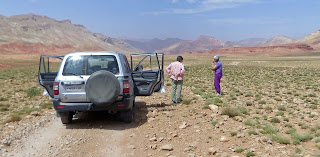I found it very hard to wake up on Day 6 to begin our
final leg to Marrakesh/Marrakech.

The riad was very comfortable and our dinner of Tagine the night before was nummy, especially when paired with a nice bottle of French wine.

Morocco is a Muslim country and as such Moroccans themselves do not imbibe but they do understand the need of for us foreigners to have a drink. Hotels and restaurants are allowed to apply for a liquor license and to serve wine and beer if they choose.
But outside the larger cities, Coke was as exciting as it got for us.

The riad was very comfortable and our dinner of Tagine the night before was nummy, especially when paired with a nice bottle of French wine.

Morocco is a Muslim country and as such Moroccans themselves do not imbibe but they do understand the need of for us foreigners to have a drink. Hotels and restaurants are allowed to apply for a liquor license and to serve wine and beer if they choose.
But outside the larger cities, Coke was as exciting as it got for us.
So with a slight headache and a fresh layer of skin we headed out. Seemingly overnight, the roads had become festooned with red banners and flags of Morocco.
King Mohammed VI was coming for a visit the next day and the town was in party mode, with everything fixed, cleaned and painted in time for his arrival.

On the previous day, we had entered a number of the small towns and villages around Quarzazate, receiving the same treatment with dozens of workers hurriedly fixing potholes, pouring new sidewalks and painting buildings that fronted the main street. You could feel the excitement in the air.
Quarzazate is home to Morocco’s film industry. They have been making movies here for over fifty years and a tour of the Atlas Studios was to be our first stop of the day. Lawrence of Arabia was filmed here so that may explain my geographical mix up as a child.


The studio tour was a decided departure from our usual diet of Kasbahs and Ksars.
Newer movies made at Atlas that you may recognize include: Last Temptations of Christ (1988), Alexander (2004), Black Hawk Down (2001), Kingdom of Heaven (2005), Babel (2006), The Mummy (1999), Star Wars (1977), The Living Daylights (1987), Gladiator (2000), and Body of Lies (2008).
Maintaining
our cinematic theme, our next stop was the Ksar of Ait Ben Haddou. The Ksar is located
on a hill above the Ounila River and was one the main stops on the caravan
route between the Sahara and Marrakech/Marrakesh.
It is a UNESCO World Heritage site and has been in existence since the 17th Century. Which is pretty good for something made out of mud.

Due to it good condition and picturesque qualities, it has been used as a set for numerous movies over the last 50 years.
It is a UNESCO World Heritage site and has been in existence since the 17th Century. Which is pretty good for something made out of mud.

Due to it good condition and picturesque qualities, it has been used as a set for numerous movies over the last 50 years.


While it is a protected site, it is occupied by a few families who make their living dealing with the thousands of tourists who visit each year.
From transportation,
to entertainment,
to selling them a nice Berber carpet to take home.

Leaving Ait Ben Haddou behind and humming Crosby, Stills and Nash we are finally on our way to the mysterious city of Marrakech/Marrakesh.
As we drove over the top of the High Atlas Mountains, we were passed by hundreds of soldiers, police, and bureaucrats in dozens of fancy cars heading to Quarzazate ahead of King Mohammed VI’s arrival.
Morocco’s constitution provides for a monarchy, parliament and an independent judiciary. The King as the head of state has extensive powers. In our discussions with Jamal, the King seemed well liked and is moving Morocco towards a constitutional monarchy all be it a bit slower then some would like.











































